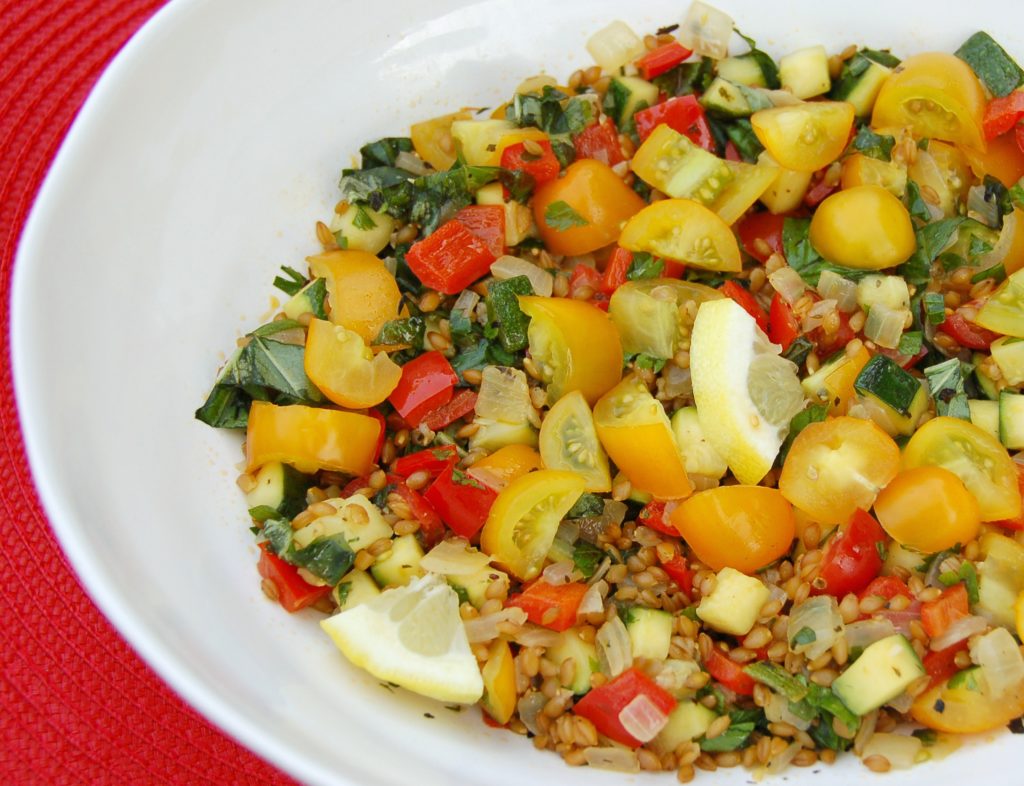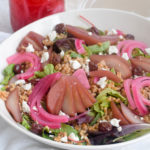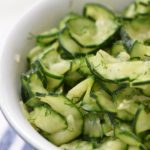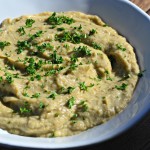My family recently returned from a wonderful trip to Santa Fe, New Mexico. I have many stories of all the delicious New Mexican cuisine we ate — a cuisine that is characterized by the question: “green or red,” referring to the kind of chiles you want on your dish, naturally. But this story is about farro, which is not a New Mexican ingredient. One of our finest meals in Santa Fe was at a restaurant called Restaurant Martín. For my main course, I ate a duck breast with pickled plums, farro and a pint nut-beer mousseline. The dish was very special and it reminded me how much I like farro. So naturally, I came home and made some for my family.
Farro is a whole grain that comes from certain, ancient species of wheat. There is some confusion about what farro is exactly because it sometimes goes by other names, including spelt and einkorn. It is about the size and shape of rice but is pale brown in color. Farro is also sometimes categorized by its size into grande, medio and piccolo forms. Other times it is labeled pearled farro. I have only ever used farro piccolo, which is the smallest and quickest-cooking size. Farro piccolo is said to be the oldest cultivated grain and there is evidence of its cultivation dating back some 10,000 years. Does that mean it is acceptable for Paleo diets?
Farro has a nutty taste and chewy texture that makes it satisfying to bite into. But it is not so chewy as to make you feel like you are eating pine needles. It does not need to be soaked overnight and cooks quickly, making it an ideal whole grain for nutritious weeknight meals. And nutritious it is. Farro is a complex carbohydrate with lots of vitamins and minerals, and best of all, it boasts twice the fiber and protein of modern wheat. You can find farro without too much trouble at good grocery stores, like Whole Foods. Or if you are nuts about heirloom grains, you can order some from Anson Farms. Store farro, and indeed all whole grains, in the freezer if you plan to keep them for a while. They will stay much fresher that way.
To cook farro, you combine it with water, bring the water to a boil and them simmer until tender — about 15-20 minutes. The farro won’t absorb all of the water, so you will need to drain it before use. You can also add farro to soups and stews as you would with barley and cook it right in the soup pot. Some people even cook it like risotto — something that I haven’t tried myself. It being summertime and all, I am using farro for vegetable salads. Come cold weather, a hearty stew or risotto will sound a lot more appealing.
Farro is so versatile that you can really use it as the base for any kind of vegetable side dish or salad. In this case, I just tried to find a pleasing combination of Mediterranean vegetables and herbs to combine with the last little bit of the Anson Mills farro piccolo I bought on a trip to North Carolina last year. The result was both delicious and eye-catching. The combination of red peppers, yellow grape tomatoes, and green herbs and zucchini is where the name “Stoplight Farro” comes from. But this recipe should definitely get a green light!
- ½ cup farro piccolo
- 3 TB extra-virgin olive oil
- 1 onion, finely diced
- 1 medium zucchini, diced
- 1 red pepper, cored and diced
- 1 tsp. Herbes de Provence
- 1 pint grape tomatoes, halved
- 12 basil leaves, cut into a chiffonade
- Zest and juice of 1 lemon
- Salt and pepper to taste
- Combine farro and 2 cups salted water in a medium saucepan.
- Bring mixture to a boil, then turn down heat and simmer until farro reaches desired degree of tenderness.
- Rinse farro in cold water and drain well
- Meanwhile, heat 3 TB olive oil in a large saute pan.
- Add the diced onion and saute until translucent, about five minutes.
- Add diced pepper and continue to gently saute until peppers are tender, about ten minutes.
- Add diced zucchini and season vegetables well with herbes de Provence, salt and pepper.
- Saute for a few more minutes until zucchini is tender.
- Add farro to saute pan and stir to combine. Remove from heat.
- Transfer farro and vegetables to a serving bowl.
- Add halved grape tomatoes, basil and lemon juice and zest. Toss to combine.
- Season salad well with salt and pepper. Drizzle a bit of fruity olive oil over salad if desired.
- Serve warm or room temperature.
I hope that this inspires you to give farro a try if you haven’t before. It’s a great addition to your repertoire of healthy and tasty whole grains!






